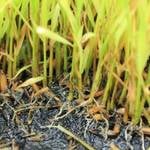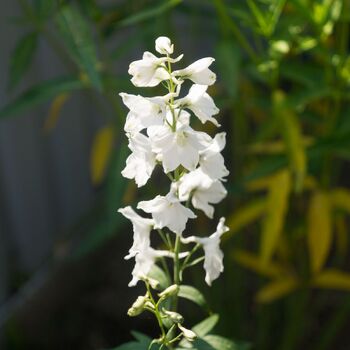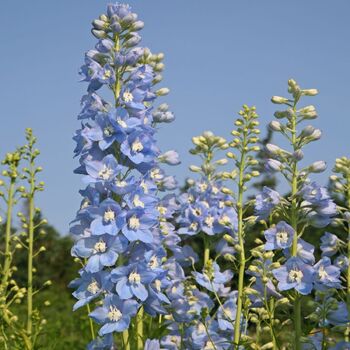
How to Grow Delphinium Seeds
Grow Guide #2263
Family: Ranunculaceae
Binomial name: Delphinium sp.
Life Cycle: Perennial (often grown as an annual)
This 'How to Grow' guide details everything a home gardener needs to know to plant, grow and care for Delphinium (Delphinium sp.).
When to Sow Delphinium Seeds
Delphinium can be grown year-round in most climates. Avoid planting in extremely hot or cold weather which can affect germination and growth. Use the table below to identify the best time of year to sow delphinium in your climate.
| JAN | FEB | MAR | APR | MAY | JUN | JUL | AUG | SEP | OCT | NOV | DEC | |
|---|---|---|---|---|---|---|---|---|---|---|---|---|
| Cool | ||||||||||||
| Temperate | ||||||||||||
| Sub-Tropical | ||||||||||||
| Tropical | ||||||||||||
| Arid |
Preparation
Delphinium plants are best grown in full sun or part shade. Choose a location that will receive at least 3 hours of full sun each day.
Delphinium plants need a well drained soil enriched with plenty of organic matter. Prepare soil by weeding it thoroughly, digging it over to loosen it and adding aged animal manure or compost. Keep the area free of weeds until planting. Learn more about preparing soil for planting here.
How to Sow Delphinium Seeds
Optional: Stratifying seeds prior to planting may improve the speed and success of germination. Stratification involves exposing the seeds to a period of cold temperature which for some species helps to break dormancy and spur the seeds to germinate. Read more about stratification here.
Delphinium seeds grow best when they are raised in trays or other containers and transplanted to the garden once established.
- Fill trays, punnets or jiffy pots with a good quality seed-raising mix, or use soil starter pellets.
- Sow seeds 5mm deep.
- Keep soil moist but never wet or dry.
- Seeds should germinate in around 10-20 days at a soil temperature of 18-21°C.
- Transplant seedlings to the garden once they have their first true leaves and are large enough to handle (usually 5-10cm tall).
- Plant out, spacing plants 30-50cm apart.
How to Grow Delphinium
Delphinium plants need regular watering during the growing season. Do not let soil dry out; keep soil evenly moist but not waterlogged. Water deeply in the early morning or late afternoon. Avoid watering the leaves of plants to avoid fungal diseases. Learn more about watering here.
If soil was well prepared no extra fertiliser should be necessary. In poor soil or to give your plants an extra boost, application of a high-potassium fertiliser or one formulated for flowering plants can be beneficial:
- Apply slow release fertiliser at the recommended rate when transplanting or when seedlings are 5-10cm tall.
- Apply liquid fertiliser at the recommended rate and frequency while plants are fruiting or flowering.
Delphinium plants may need to be supported as they grow. Depending on the expected size and height of the plant, use a stake, bamboo cane, trellis or string lines to support plants. Make sure you have the support in place when you sow seed or transplant seedlings to avoid disturbing the plant's roots later.
Optional: Pinch out the growing tips of delphinium plants to encourage denser growth with stronger stems and more flowers. Using sharp secateurs or snips remove the top set of leaves, cutting just above a set of lower leaves.
Delphinium plants should flower in approximately 130-150 days.
Deadhead delphinium flowers regularly during the growing season. Using sharp secateurs or snips cut fading or dead flowers off just above a set of leaves. Removing old flowers regularly will encourage plants to produce more flowers. Learn more about deadheading flowering plants here.
When plants have finished flowering prune them back to neaten them and encourage strong new growth. Using sharp secateurs or snips, cut individual stems just above a set of lower leaves. Cut each flower spike to 5cm above ground level.
Common Problems when Growing Delphinium
Like all plants, delphinium is susceptible to some pests, diseases and other problems. Below is a list of the most common problems gardeners encounter when growing delphinium plants:
 Damping off is caused by a fungal growth that transfers from the soil to seeds or tender seedlings. Seeds may appear not to germinate, or young plants start to rot when they emerge from the soil and become soft and mushy at the base before dying. Use new potting mix if raising seedlings, do not water foliage and avoid waterlogged soil. Read more about damping off here.
Damping off is caused by a fungal growth that transfers from the soil to seeds or tender seedlings. Seeds may appear not to germinate, or young plants start to rot when they emerge from the soil and become soft and mushy at the base before dying. Use new potting mix if raising seedlings, do not water foliage and avoid waterlogged soil. Read more about damping off here..jpg) Powdery mildew is caused by fungal spores reproducing on the leaves of plants. First showing as white spots on leaves, affected areas can spread quickly to cover the entire leaf surface. While rarely fatal, powdery mildew can reduce yields. Water plants at soil level (not on leaves) to prevent spreading spores, allow good air flow between plants, remove affected leaves and if necessary spray with an appropriate fungicide or homemade spray. Read more here about powdery mildew here.
Powdery mildew is caused by fungal spores reproducing on the leaves of plants. First showing as white spots on leaves, affected areas can spread quickly to cover the entire leaf surface. While rarely fatal, powdery mildew can reduce yields. Water plants at soil level (not on leaves) to prevent spreading spores, allow good air flow between plants, remove affected leaves and if necessary spray with an appropriate fungicide or homemade spray. Read more here about powdery mildew here. Slugs and snails are molluscs that feed on tender leaves and shoots, mostly at night, leaving slimy trails behind them. Control them by removing their hiding places, keeping free range poultry, collecting them by torchlight or by placing traps. Read more about slugs and snails here.
Slugs and snails are molluscs that feed on tender leaves and shoots, mostly at night, leaving slimy trails behind them. Control them by removing their hiding places, keeping free range poultry, collecting them by torchlight or by placing traps. Read more about slugs and snails here.


.png)






